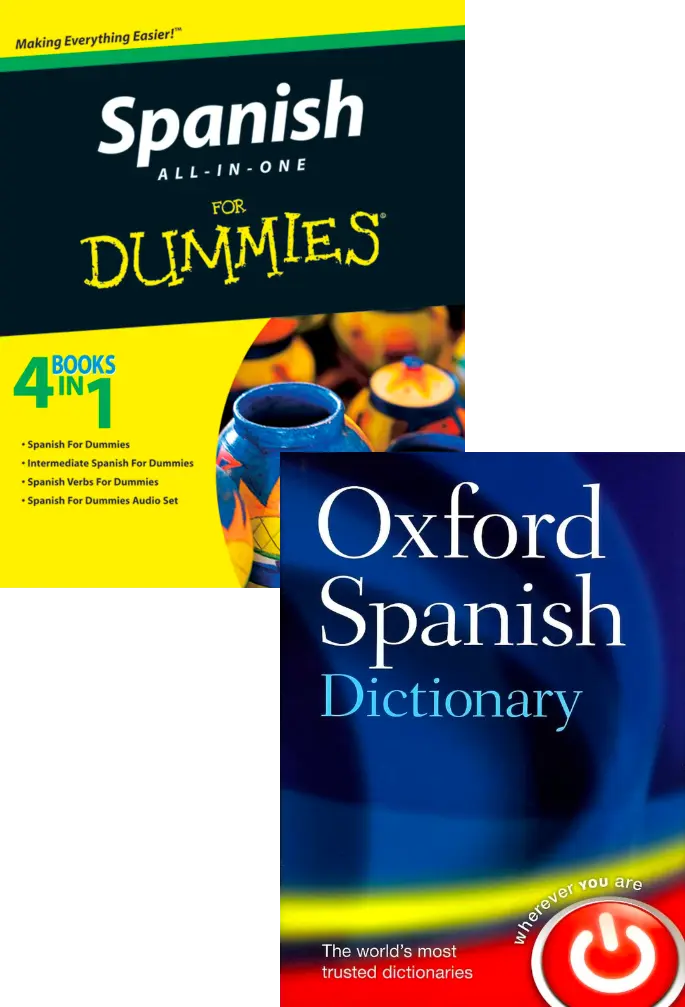Spanish Classes with Native Spanish Tutors
Book a Course Now
Among the various languages that are spoken in Canada, Spanish is one of the most popular. This shouldn’t come as a surprise, as according to the 2016 census, there are approximately 396,460 Canadians of full or partial Spanish heritage and around 447,325 immigrants that come from Latin American countries. Whether you belong to some of these communities or not, there are plenty of advantages to learning this fascinating language, like expanding your social life, becoming more employable in the country and abroad, and keeping your mind sharp. What’s more, because Spanish is spoken by more than 592 million speakers worldwide, once you reach fluency you’ll be able to communicate with ease in countries like Argentina, Chile, Mexico, Uruguay, Ecuador and Spain, and even understand quite a few words and phrases in other languages like Italian and Portuguese, so if you’re planning to travel around the globe, learning this language is definitely a smart move.
In short, regardless of where in Canada you live, learning Spanish can be highly beneficial. However, learning a foreign language can be challenging, especially if you’ve never done it before. To make it easier for you, here’s a guide to how to learn Spanish that will help you reach your language goals and become a proficient speaker in next to no time.
Language Trainers organizes Spanish courses in almost any destination!
All classes are taught by qualified, native speaker Spanish trainers and can be arranged at your office or home for any day of the week (including weekends) in the morning, afternoon, or evening.
City Quick Search
Spanish lessons in...
1. Why Learn Spanish Today
There are plenty of reasons why learning Spanish is one of the smartest things you can do this year. To inspire you to learn this wonderful language, here are some of the most important ones.
To Take Your Career to the Next Level
Did you know that economic relations between Canada and Mexico accounted for more than 20 billion dollars in 2020? This means that if you own a business, speaking Spanish can be a great way to increase your sales, get new clients and take advantage of the many trades that take place between Canadian and Hispanic companies. What’s more, if you’re in between jobs at the moment and you’re interested in becoming more employable, having Spanish on your CV can be a great way to impress local employers and get a bilingual position in top Canadian companies that hire Spanish speakers like Procom, Randstad Canada and Global Fleet Management Inc.
To Travel Around the World
As the official language of 21 countries in Latin America, Europe and the Caribbean, Spanish is one of the best languages you can learn if you love travelling. Although there are plenty of language variants, they are all mutually intelligible, so no matter if you decide to learn European or Latin American Spanish, you’ll be able to communicate all around the globe with ease. This will open up many opportunities for you to enjoy these various locations like a true native, as you’ll be able to connect with locals more deeply, understand their culture and take part in their celebrations. On top of that, speaking the language will allow you to move more independently in countries like Colombia, Honduras, Costa Rica and Venezuela, and even access secret locations that are usually kept from tourists.

Spain

Mexico

Colombia

Argentina
To Connect with Relatives
Whether you’re part of the Spanish Canadian community or are married to someone who was born in a Hispanic country, speaking the language will give you a unique insight into the cultures where Spanish is spoken, which can completely change the way you understand your loved one’s heritage or your own. In addition to this, once you master the language you won’t have to worry about language barriers, so you’ll get to communicate much more freely and truly get to know your relatives without having someone translate everything they say.
”I have nothing but praise for Mrs. Lucia, my Spanish teacher. We had a very good interaction and she was able to keep our meetings interesting, helpful and professional. I would strongly recommend her to Spanish learners of all levels. And thank you, Language Trainers! It was good to know that you were there, watching our backs!”
Zauder Castro - Spanish course in Houston
Why Learn Spanish to Travel Around the World
If you are an avid traveller, then you already know the importance of knowing the local language to get by in a foreign country. Especially, in places like Central or Latin America where bilingualism in English is not widespread. For instance, all the street signs, magazines, restaurant menus, etc. are in Spanish. You’ll be lucky if you find something in English at the airport!
Furthermore, there’s no better way to connect with the local culture than by knowing the local language. Learn Spanish and you will get to know more about their customs and traditions, and you’ll even be able to discover secret places unknown to tourists. You won’t be restricted to resorts or hotels where everybody speaks only English!

To Become Multilingual
Spanish is one of the best languages to learn if you’ve never studied a foreign language before because of the many cognates that exist between it and English, so it’s not as intimidating as other languages like Mandarin or Hungarian. On top of that, once you learn Spanish, it will be much easier for you to study other Romance languages, so if you’re planning on becoming a polyglot in the future and studying many more European languages, learning Spanish can be a great first step to achieving that.
2. Tips to Learn Spanish More Effectively
Now that you know about the amazing benefits of learning Spanish, you probably can’t wait to start learning. However, before you do, read the following recommendations so that you can avoid making some of the most common mistakes and learn Spanish more effectively.
Find a Spanish Tutor
If you want to learn the language as fast as possible, one of the first things you should do in your journey to fluency is to find a qualified native Spanish teacher who can guide you through your learning process. This will ensure you get access to high-quality, updated materials, and have someone to practice the language with every week. On top of this, a native trainer will teach you interesting facts about Spanish, as well as commonly used phrases that aren’t in textbooks, so if you want to expand your knowledge of the language, getting the help of a professional is the way to go. It’s also ideal for those wanting to get to know Hispanic cultures, as having the chance to talk to a native frequently will open up the possibility of asking anything you want to know about the traditions and customs of people in Spain or Latin America.
Make and Use Flashcards
Learning your first Spanish words and phrases can be challenging, especially if you’ve never learned a foreign language before. However, there are many tools you can use to make it easier for you, like flashcards. Flashcards are cards that have a word on one side, and its meaning on the other, and if you use them regularly, they’ll help you memorize new vocabulary really quickly. Fortunately, you don’t have to spend any of your time making your own deck, as nowadays there are plenty of apps you can use to access flashcards made by other users, like Anki, Quizlet or Tinycards, so download any of these and start learning right now!
Learn Words in Context
Although at the beginning you might find yourself trying to memorize long lists of words in Spanish, like greetings and commonly used verbs, doing this often can get repetitive and boring. Because of that, if you want to expand your vocabulary in a more effective and entertaining way, you should aim to learn words and phrases in context. This is done simply by immersing yourself in the language, so the more you listen to natives and read in Spanish, the more you’ll expose yourself to new vocabulary. The main advantage of learning this way is that instead of studying words in isolation, you’ll be able to know how to use them in a sentence, which will help you remember them more. So, for example, instead of trying to learn a list of words related to cooking by heart, you could watch a cooking show in Spanish like Cocina Abierta de Karlos Arguiñano and write down all the new words and phrases you hear.
Watch Out for False Cognates
Because English has so many words that are derived from Latin, like fame, pirate or even the word language, there are many Spanish words that you’ll understand without having to look up what they mean. However, you should be mindful of false cognates, also called false friends, which are words in Spanish that look like English words, but have completely different meanings. To help you avoid making mistakes, here are some of the most common ones.
- The Spanish word pie might look like the English word pie but actually means foot.
- The Spanish word carpeta might look like the English word carpet but actually means folder.
- The Spanish word ropa might look like the English word rope but actually means clothes.
- The Spanish word éxito might look like the English word exit but actually means success.
- The Spanish word grapa might look like the English word grape but actually means staple.
- The Spanish word fábrica might look like the English word fabric but actually means factory.
- The Spanish word recordar might look like the English word record but actually means to remember.
- The Spanish word lectura might look like the English word lecture but actually means reading.
- The Spanish word pan might look like the English word pan but actually means bread.
- The Spanish word realizar might look like the English word realize but actually means to do.
- The Spanish word introducir might look like the English word introduce but actually means to insert.
- The Spanish word pariente might look like the English word parent but actually means relative.
Want to check out some more examples? Take a look at English-Spanish False Cognates That Could Ruin Your Dating Life!
Use Language Apps
If you want to make the best use of your free time and improve your Spanish skills without even noticing it, you should start using language apps. In case you’re finding it hard to choose one, here are some of our top picks.
- Want to learn European Spanish? If so, you should try Mondly, a free language app that can help you understand basic grammar and learn useful words in Spanish. One of the best features of this app is that it offers a unique new lesson every day, which means you can use it regularly and always enjoy new content. On top of this, you can click on any verb you see and you’ll access a full list of all the conjugations of that verb, so if this is something you need to work on, you should definitely give this app a chance.
- Another great option is LingoDeer, a grammar-based platform where you can learn both European and Latin American variants. This app is probably the one that most resembles a traditional language course because it offers detailed grammar explanations that will help you understand the language in-depth from day one. Because of that, it’s ideal for people that prefer learning with a linear, organized curriculum, so if this is you, give it a try and you won’t regret it.
- Do you find that you get too distracted when learning Spanish? Then you should try Pimsleur, an app based on an audio system which promises to eliminate any noise or distraction. One of the best features of this app is that it divides words into syllables, so if you find Spanish pronunciation too hard, you should definitely consider giving Pimsleur a go.
- Lastly, if you want to expand your vocabulary through repetition, translating and quick exercises that will make you feel like you’re playing a game, you have to try Duolingo. This app is perfect for those that want to learn both variants of the language, as it makes no distinction between European and Latin American Spanish and instead teaches you a bit of both. In addition to this, one of the most important reasons why you should use this app is because it’s almost completely free, so you’ll be able to access most of the content of the Spanish course without having to pay a cent.
Take Spanish Level Tests
This is another useful tool you can use from day one, as it will not only allow you to assess your current skill level, which can be really helpful if you don’t know how good your Spanish skills really are but also to check the progress you make throughout the year. On top of that, you can use these tests to know exactly what Spanish proficiency level you should put in your CV, or to find appropriate materials to study the language, so as you can see, they have multiple uses.
Want to know how fluent in Spanish you are? Take our FREE Spanish Level Test now and in a few minutes, you’ll get a score that will help you know if you have a beginner, intermediate or advanced level.
3. Ways to Immerse Yourself in Spanish
If you want to become a Spanish speaker fast, you have to immerse yourself in the language as much as possible. Doing this will not only ensure you improve your language skills but also learn interesting things about the fascinating countries where Spanish is spoken, so it’s a very important part of your journey to fluency. Can’t afford to travel? Don’t worry! Take a look at some of the ways you can immerse yourself in the language without leaving your house.
Read in Spanish as Much as You Can
If you want to boost your reading skills and have the lexicon of a native speaker, you should make it a habit to read in Spanish every day. If you’re a complete beginner, you can start with really simple texts like children’s books such as La Sirenita or La Bella Durmiente, which contain easy words you’ll understand and are written in the present tense. If you can already understand intermediate Spanish texts, you can move on to reading newspapers like El Pais, El Mundo, CNN En Español or BBC Mundo, which in addition to helping you learn new vocabulary will allow you to be up-to-date with the latest events in the Hispanic world. On the other hand, if you prefer to read interesting facts about languages, you should check out our Spanish blog where you’ll find plenty of articles written by language professionals that you can’t miss.
Watch Videos in Spanish
Do you enjoy watching YouTube in your free time? If so, you should visit some of these channels made by Spanish teachers.
Dreaming Spanish, where you’ll get to hear different stories that range from really simple ones most learners will understand, to complex discussions about politics, Spanish history and technology.
Learn Spanish Faster, which is ideal for learners that want to master Caribbean Spanish and learn useful things like how to order food in Spanish, or how to conjugate common verbs.
Spanish Like a Pro is perfect if you want to improve your listening skills while you have some fun. It’s hosted by friendly puppets who will teach you about different aspects of the language, like grammar, pronunciation and vocabulary, so regardless of your Spanish level, you should check it out.
Bilingüe bros covers interesting topics like accents, commonly used phrases and even lessons on how to roll your ‘r’s, so if you’re looking for original content, you should definitely watch this channel.

Listen to Podcasts in Spanish
Frequently listening to podcasts is a great way to train yourself to understand native speakers, while at the same time getting familiarized with Spanish sounds, which can really impact your pronunciation. On top of being a really useful tool, podcasts are completely free and you can listen to them while doing other things, so they’re definitely something you should include in your daily routine. Don’t know any podcasts? Take a look at some of the best ones.
- Audiria is a lively and engaging podcast series created by two brothers who live in Malaga, Spain. It’s set entirely in Spain and focuses on promoting the Spanish language and culture, so if you dream about going to Spain one day and want to get to know interesting information about this beautiful country, check out any of the more than 800 episodes that are available.
- El Oso Latino Habla Español is another great podcast that features interviews, music, jokes, grammar explanations and other interesting aspects of Latin American Spanish and the cultures where it’s spoken.
- Cosas de Internet is an excellent podcast for intermediate or advanced Spanish learners who are interested in technology and the interest, as the two hosts discuss topics like Artificial Intelligence, QWERTY keyboards and social media.
- Lastly, if you are interested in astronomy and you want to learn about it in Spanish, you should listen to Obsesión por el Cielo, where the host tries to bring the mysteries of outer space closer to the listeners in a way that’s understandable.
4. Common Spanish Phrases
To survive your first conversation in Spanish in Canada or abroad here’s a list of some of the most useful words and phrases you should learn.
| English Version | Spanish Version | |
|---|---|---|
| Talking about yourself | My name is… | Mi nombre es…/Me llamo… |
| I am…years old | Tengo…años | |
| I’m from… | Soy de… | |
| I like… | Me gusta… | |
| Questions in Spanish | What’s your name? | ¿Cómo te llamas? |
| How old are you? | ¿Cuántos años tienes? | |
| Where are you from? | ¿De dónde eres? | |
| Where do you live? | ¿Dónde vives? | |
| Do you speak Spanish? | ¿Hablas español? | |
| Do you speak English? | ¿Hablas inglés? | |
| What time is it? | ¿Qué hora es? | |
| How are you? | ¿Cómo estás? | |
| Answering questions in Spanish | Yes/No | Sí/No |
| Maybe | Tal vez | |
| Never | Nunca | |
| Always | Siempre | |
| It depends… | Depende… | |
| Of course | Claro/Por supuesto | |
| Fine | Bien | |
| Not so good | No tan bien | |
| So-so | Mas o menos | |
| Spanish Greetings | Hello! | ¡Hola! |
| Good morning! | ¡Buenos días! | |
| Good afternoon! | ¡Buenas tardes! | |
| Good evening! | ¡Buenas noches! | |
| Welcome! | ¡Bienvenido! / ¡Bienvenida! | |
| Saying Goodbye | Goodbye! | ¡Chau! / ¡Adiós! |
| See you later! | ¡Hasta luego! | |
| See you tomorrow! | ¡Hasta mañana! | |
| Take care! | ¡Cuídate mucho! | |
| See you | Nos vemos |
Ready to take your Spanish skills to the next level? If so, stop wasting time trying to learn this beautiful language on your own and book a language course at Language Trainers! All you need to do to start learning with us is send us a quick inquiry right now and one of our team members will get in contact with you in the next 24 hours to answer all your questions and find out what kind of course you need. In the meantime, take a look at our social media where you’ll find some extra tips and recommendations to learn Spanish like a pro.

Switch between online and face-to-face Spanish classes with a hybrid course!
Existing student?
Continue your language development and learn with your same teacher face-to-face
New Student?
Start your clases online and switch to face-to-face later
“Prueba tu Español”...
Can't find a Spanish teacher who can help you prepare for your school/uni exams?
We can help.
Preferred Supplier
Language Trainers is the preferred supplier for




How to Book

Take our Spanish Language Level Test.

Let us know why you need to learn Spanish and include the time and location that best suit you.

Review our quote and, if you are happy with it, receive our invoice and Agreement form.

Sign our Agreement form and submit a deposit* for the course.

Receive confirmation from our team with your Spanish tutor’s details.

Begin your Spanish training and receive your Spanish course book.
Click to find out more.
Frequently Asked Questions
Case Studies: Clients

“Yes, the program has been extremely helpful. My teacher was the most helpful and useful”
Spanish course in TampaClient testimonials
See some of the testimonials we have received from our clients.”My teacher Angelica is wonderful!”
Spanish course in”The first class went great! Angelica is helping a lot. This course is definitely what I was looking for! ”
Spanish course in















